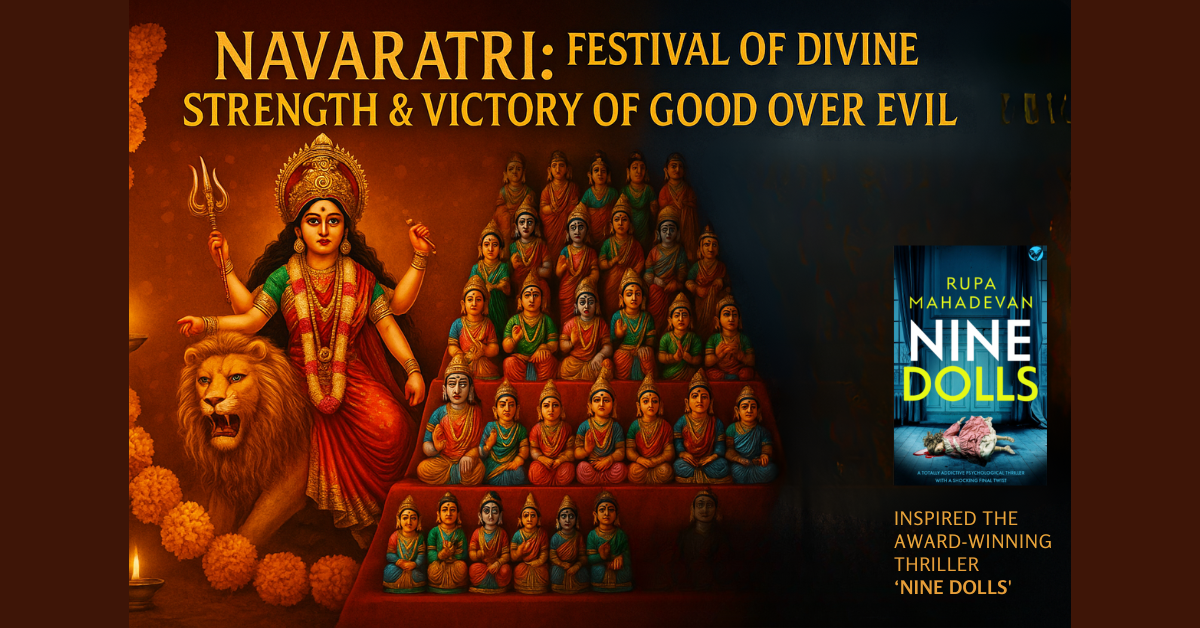By Rupa Mahadevan –
Navaratri is one of the hundreds of Hindu festivals, symbolising the timeless triumph of good over evil, and an embodiment of women’s empowerment. The word Nava-Ratri literally means “Nine Nights,” and the festival spans nine nights and ten days, dedicated to the worship of Goddess Durga and her epic battle against the demon king Mahishasuran.
The Legend of Mahishasuran and Maa Durga
According to legend, Mahishasuran — the Bull Demon — was a powerful king who ruled Earth thousands of years ago. Blessed with a boon that made him nearly invincible, he could not be defeated by man, god, animal, illness, or old age. Empowered by this gift, he became arrogant and merciless, unleashing terror and suffering across the world.
Explore more at our Events & Festivals Section.
The gods, unable to stop him, united their divine energies to create Maa Durga — a fierce and radiant goddess, embodying unmatched courage, wisdom, and strength.
For eight nights, Maa Durga fought Mahishasuran’s vast and ferocious army, destroying it piece by piece. On the ninth night, she faced Mahishasuran himself in a final, intense duel under the starry sky. After a relentless battle, the goddess vanquished the demon, restoring peace and righteousness.
The tenth day, known as Vijayadashami or Dussehra, marks this victory and is celebrated as the day of triumph.
The Legend of Mahishasuran and Maa Durga
According to legend, Mahishasuran — the Bull Demon — was a powerful king who ruled Earth thousands of years ago. Blessed with a boon that made him nearly invincible, he could not be defeated by man, god, animal, illness, or old age. Empowered by this gift, he became arrogant and merciless, unleashing terror and suffering across the world.
The gods, unable to stop him, united their divine energies to create Maa Durga — a fierce and radiant goddess, embodying unmatched courage, wisdom, and strength.
For eight nights, Maa Durga fought Mahishasuran’s vast and ferocious army, destroying it piece by piece. On the ninth night, she faced Mahishasuran himself in a final, intense duel under the starry sky. After a relentless battle, the goddess vanquished the demon, restoring peace and righteousness.
The tenth day, known as Vijayadashami or Dussehra, marks this victory and is celebrated as the day of triumph.
Regional Celebrations Across India
Though less familiar outside India, Navaratri is a vibrant and colourful celebration across the country, with each region adding its own cultural touch:
- In South India, families arrange dolls and idols on decorated steps (Golu), representing deities, saints, and mythological scenes.
- In North India, grand statues of Maa Durga are worshipped in elaborately decorated pandals, often accompanied by music, dance, and storytelling.
Across all traditions, dolls and idols remain central, retelling the story of the goddess’s bravery and the universal message of good overcoming evil.
The Deeper Significance
Navaratri is not just a religious festival but a celebration of feminine strength, resilience, and divine energy. It serves as a reminder that courage, compassion, and truth ultimately conquer arrogance, cruelty, and injustice.
This spirit is beautifully echoed in the timeless verses of the Bhagavad Gita:
यदा यदा हि धर्मस्य ग्लानिर्भवति भारत ।
अभ्युत्थानमधर्मस्य तदाऽअत्मानं सृजाम्यहम् ॥
परित्राणाय साधूनां विनाशाय च दुष्कृताम् ।
धर्मसंस्थापनार्थाय सम्भवामि युगे युगे ॥
(Bhagavad Gita 4.7–4.8)
“Whenever righteousness declines and unrighteousness rises, O Arjuna, at that time I manifest Myself on Earth. To protect the righteous, destroy the wicked, and establish dharma, I appear age after age.”
Bommai Golu: Dolls That Tell Stories
One of the most enchanting traditions of Navaratri, especially in South India, is the Bommai Golu (literally “Dolls Display”). Families set up rows of steps covered in pristine white cloth and fill them with colourful dolls and figurines. The carefully arranged displays are not just devotional but deeply artistic, blending myth, folklore, and everyday life.
Order yours from E-Scout Services India.
While the deities are central, what makes Golu truly captivating are the scenes of human life. These figurines bring warmth and storytelling flair to the display:
- The Chettiar Merchants – plump, cheerful dolls with wide smiles and big bellies, representing wealth, hospitality, and trade.
- The Marapaachi Dolls – the quintessential black wooden dolls, said to ward off evil eyes and symbolise fertility. They are passed down across generations.
- Temple Festivities – vibrant recreations of rural celebrations with dancers performing the peacock dance, horse dance, and musicians playing traditional instruments. These lively figurines capture the colours and joys of times past.
For me, the human dolls always stood out. While deities often followed strict iconography — four arms, a certain garment, an elephant’s face, or coins spilling from palms — the human figures felt freer. Some frowned, some carried mystery in their eyes, others smiled knowingly. Each doll seemed alive, like Maa Durga’s own celestial army retold in clay and paint.
How Literature Shaped Nations: The Parallel Legacies of Walter Scott and Bankim Chandra
The Divine Displays
Of course, no Golu is complete without its grand sets of deities:
- The Dashavatara (Ten Avatars of Vishnu) – from Matsya (the Fish) to Kurma (the Tortoise), Narasimha (the Lion-Man), and Vamana (the Dwarf), the sequence beautifully mirrors the idea of evolution long before science articulated it.
- The Ashta Lakshmi (Eight Forms of Goddess Lakshmi) – symbolising virtues from courage to intellect, kindness to prosperity. These sets highlight how Indian traditions celebrated womanhood and empowerment within a mature, inclusive society.
Together, these divine displays and human stories transform Navaratri Golu into a vibrant tapestry of history, philosophy, and imagination.
A Personal Connection
Growing up, Navaratri Golu was my favourite festival — even more than the fireworks of Diwali or the harvest feasts of Sankranti. My sister and I would compete fiercely to create the most memorable themes, from mythological scenes to playful village life.
So when I finally decided to pursue my passion for storytelling — this time in crime and thrillers — it felt natural to return to the world of dolls that had fascinated me since childhood.
My Book: Nine Dolls
That’s why my debut novel, Nine Dolls, revolves around this very festival. Winner of the Joffe Books Prize 2024, it’s an award-winning psychological thriller set in a remote Scottish manor during the Hindu Dolls Festival.
📖 Pre-order from 4th September 2025
📅 Publishing on 25th September 2025
✨ Winner of the Joffe Books Prize 2024
Synopsis
When a group of friends reunite to celebrate the Hindu Dolls festival 🪆 in a storm-battered Scottish manor 🏠 in Oban, the night takes a sinister turn. Dolls move. Secrets surface. And one of them is willing to kill to protect the truth.
Nine nights.
Nine secrets.
And one unforgettable name…
🔪 Nine Dolls – dark, addictive, and chilling to the core.
🖤 Every day unveils another secret.
🖤 Every lie pulls you deeper into the nightmare.
🖤 Every doll hides a truth you’re not ready to face…
👉 Pre-order now on Amazon






